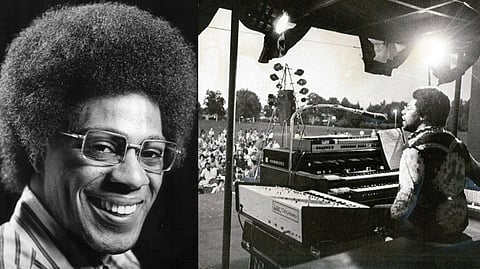

It was 1974, and Don Lewis was getting tired of hauling around so many keyboards. One day he would be in a studio in Los Angeles, working alongside Quincy Jones. A week later, he might be on tour as a member of the Beach Boys’ backup band. Or he might be performing his own gigs, shuffling up and down the West Coast with an ever-growing assortment of keyboards and other equipment.
He could have just taken his trusty Hammond Concorde organ, itself not a small item. But Lewis was an aural explorer, constantly on the hunt for new sounds. If he found a keyboard with a particular tone to it, he had to add it to his collection. He was a one-man band; he aspired to be a one-man orchestra. His problem was about more than sheer weight. Each instrument had to be controlled separately, and there was no industry standard for integrating them. An electrical engineer by training, he decided to strip them down for parts and build something new. It took him three years of designing and fund-raising, but in 1977 he finalized the Live Electronic Orchestra, commonly known as the LEO.
This musical Frankenstein’s monster brought together pieces from three keyboards, a slew of synthesizers, control panels and a drum machine into a set of plexiglass modules. Lewis sat in the middle, like a musical air traffic controller. His design allowed him not only to choose the sounds he wanted, but also to mix them in real time.
Lewis, 81, died on Nov. 6 at his home in Pleasanton, Calif. His wife, Julie Lewis, said the cause was cancer.
These days, people are used to the idea that they can produce virtually any sound they want on a laptop. That was far from the case in the 1970s, but Lewis found a way to create a symphony of sound at his fingertips.
The LEO cost more than $100,000, and he never made another. Still, it was a hit. He played six nights a week in a packed bar along Fisherman’s Wharf in San Francisco. Among his many fans was an engineer named Ikutaro Kakehashi, who was so inspired by Lewis’s invention that he went on to develop, with Dave Smith, the musical instrument digital interface, known as MIDI, the protocol that makes modern music production possible. (Smith died at 72 in June.)
A big part of Lewis’s success as a live musician was getting audiences to listen to him and not gawk at his keyboard rig. His technology was so clever, so seamless, that most people soon forgot about it entirely and allowed the music he created to sweep them away. He was an unsung pioneer of electronic music who paved the way for a billion beeps, boops and oonz-oonzes to come.
He wasn’t without his critics, who said that he was not a musician at all but a mere button-pusher. In the mid-1980s, members of the musicians’ union protested his performances, claiming that he would drive them out of business. He challenged their right to picket him before the National Labor Relations Board. He lost. The prospect of having to cross a picket line just to do his job was too much. He stored the LEO in his garage and tried to put the whole experience behind him. Several years later, the government re-examined his case, and this time decided in his favor — and even gave him a settlement. He didn’t bring back the LEO, though. He donated it to the Museum of Making Music in Carlsbad, Calif., where it sits on display today.
Visit news.dtnext.in to explore our interactive epaper!
Download the DT Next app for more exciting features!
Click here for iOS
Click here for Android